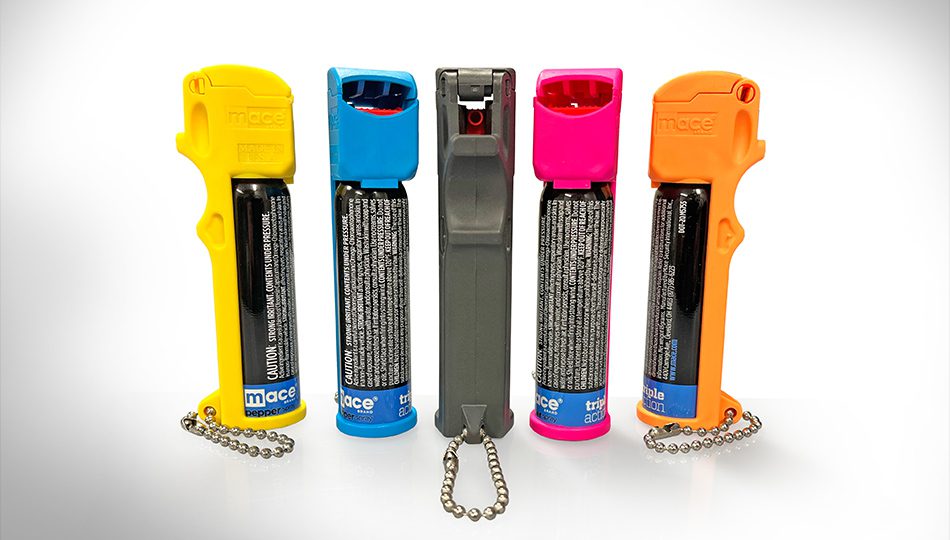
Let’s face it, we live in an unpredictable world, which is why personal safety has become of paramount concern. This issue has led to the development of various self-defense products, including Mace® spray. If you’ve ever wondered about Mace spray—its uses, effectiveness, and how it compares to other defense sprays—you’ve come to the right place.
We’ll delve into the world of Mace spray, shedding light on its active ingredients, its effectiveness, and its differences from other defense products. So let’s begin by addressing the primary question:
What is Mace Spray?
Mace spray, often referred to simply as “Mace,” is a type of self-defense product designed to deter and incapacitate potential attackers. It’s considered a nonlethal tool that individuals can carry for personal safety. The term “mace” is often used generically to describe various defense sprays, but it originally referred to a specific brand of defense spray that contained an agent called phenacyl chloride.
Phenacyl chloride—also known as chloroacetophenone—is a chemical compound that irritates the eyes and respiratory system, causing temporary discomfort, pain, and impaired vision. As time passed, the formula evolved, and Mace spray now contains oleoresin capsicum (OC). When Mace spray is released, the agent creates a burning sensation in the eyes, leading to tearing, coughing, and general discomfort. This reaction is intended to disorient an attacker and provide the victim with an opportunity to escape or seek help.
Enjoying this content? Find out how you can get more sent straight to your inbox.
What Does Mace Spray Do?
When Mace spray is released, the OC irritates the mucous membranes, causing intense burning, pain, and temporary blindness. This reaction is meant to induce a strong instinctual response in the attacker, granting the victim an opportunity to escape or seek help. Mace spray comes in various forms, such as canisters, pens, and keychains, making it easy to carry and access when needed.
Are Pepper Spray and Mace the Same Thing?
The terms “pepper spray” and “Mace” are often used interchangeably, as Mace is a brand of pepper spray. Both defense sprays aim to deter attackers, and pepper sprays in general primarily contain OC derived from pepper oil. It’s the concentration of OC and the propellants that typically differ.
Active Ingredient Distinction
Mace spray affects both the respiratory and visual systems, inducing temporary blindness alongside intense pain and discomfort. But when it comes down to it, both pepper spray and Mace do the same thing, just with different concentrations or with varying propellants. Efficacy can vary, which is one reason it’s wise to use a proven brand.
How Painful is Mace Spray?
Mace spray’s primary purpose is to temporarily incapacitate attackers by causing significant pain and discomfort. When an individual is exposed to Mace spray, they may experience intense burning sensations on the skin and in the eyes. The eyes become irritated and swollen, often leading to temporary blindness. The respiratory system is also affected, causing coughing, choking, and difficulty breathing.
Temporary Effects
It’s important to note that while the effects of Mace spray are painful and distressing, they are usually temporary and wear off after a relatively short period, typically within 30 to 45 minutes. Immediate decontamination through methods such as rinsing with cold water or a combination of baby shampoo and cold water can help alleviate the discomfort.
Is Mace Stronger Than Bear Spray?
Mace spray and bear spray serve different purposes and have different formulations, which can affect their potency and effectiveness in specific situations. Generally, bear spray is considered to be stronger than Mace spray in terms of its immediate effects and potency.
Bear spray is specifically designed to deter bear attacks. It contains a higher concentration of the active ingredient oleoresin capsicum (OC) than typical Mace sprays. The higher concentration is necessary to effectively deter large and potentially aggressive animals. When used against bears, the strong OC concentration causes intense irritation to the bear’s eyes, nose, and throat, temporarily incapacitating it and giving the person a chance to retreat safely.
On the other hand, Mace spray was historically designed for use against humans, particularly by law enforcement. Its effects might not be as potent or specialized for animal deterrence as bear spray.
In situations involving human self-defense, Mace spray is suitable due to its intended effects on human physiology, such as causing temporary blindness and disorientation. However, when it comes to protection against bears or other large animals, bear spray is specifically formulated to deliver a higher concentration of OC for more immediate and effective incapacitation.
It’s important to use each type of spray for its intended purpose. Using bear spray on humans or Mace spray against bears might not yield the desired results and could even lead to potential risks and serious complications. Before venturing into bear habitats or purchasing any type of spray for self-defense, it’s advisable to research local regulations, understand the proper usage, and choose the appropriate product based on the potential threats you might encounter.
Legal Considerations
When it comes to legality, both Mace spray and bear spray have varying regulations depending on your location. It’s crucial to familiarize yourself with local laws and regulations before purchasing and using any defense spray. In addition, it’s your responsibility to read the labels and adhere to restrictions regarding the product’s use.
Peace of Mind
Knowing that you have a tool like Mace spray at your disposal can provide peace of mind. It provides an accessible, nonlethal means of self-defense that empowers individuals to protect themselves from potential threats. Its effectiveness, convenience, and legality make it a valuable tool for enhancing personal safety and security.
In an age where personal safety is of utmost importance, understanding the different defense products available can empower individuals to make informed decisions about their safety strategies. Mace spray, with its active ingredient oleoresin capsicum, provides a nonlethal means of temporarily incapacitating attackers.
Remember that Mace spray, when used responsibly, can provide an effective tool for self-defense. However, it’s essential to prioritize safety, legality, and awareness of your surroundings. Whether you’re navigating city streets or exploring the great outdoors, having knowledge about defense products like Mace spray can contribute to a safer and more secure environment for everyone.
Your Protection Starts Here!
The information provided herein is solely an overview intended to provide general information and should not be considered legal advice. All rights to this work are reserved. No part of this work may be reproduced or copied in any form or by any means without prior written consent. U.S. LawShield® is a Legal Defense for Self Defense® Program, not a law firm. Membership in the U.S. LawShield Legal Defense for Self Defense Program is not a guarantee of any particular outcome. All legal services are provided by independent third-party program attorneys who are part of the Program. Visit uslawshield.com for terms, conditions, restrictions, and insurance licensing information.
Disclaimer:
All third-party trademarks referenced herein are the property of their respective owners. The use of third-party trademarks does not indicate any relationship, sponsorship, or endorsement between U.S. LawShield® and the owners of these trademarks. Any reference to third-party trademarks is to identify the corresponding goods and/or services and shall be considered nominative fair use under trademark law.





Leave A Comment